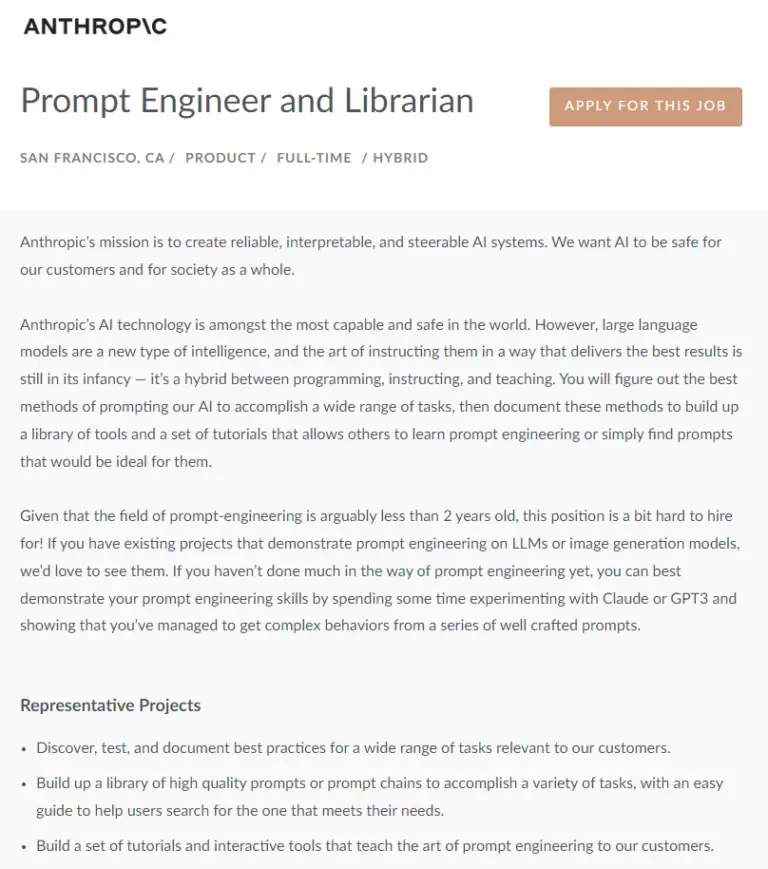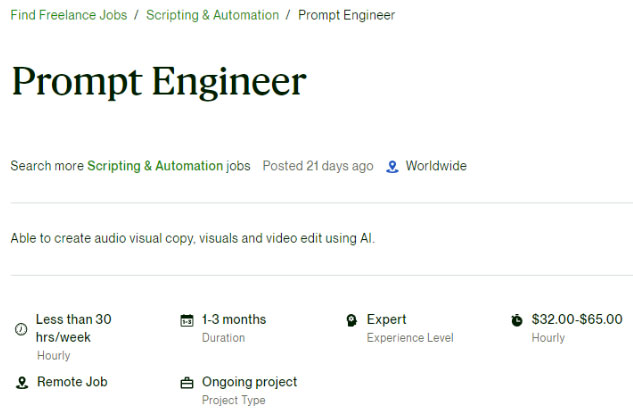The popularization and widespread use of tools like ChatGPT have opened the door to a brand new skillset many call AI prompt engineering.
An AI prompt engineer possesses a nuanced understanding of effectively interacting with large language models and generative image models like ChatGPT, Stable Diffusion, or Midjourney in order to generate the desired output.
While many of us have dabbled in using ChatGPT to compose fictional stories or draft work-related emails, prompt engineering aims to unlock unique and valuable applications of these models.

Given that prompt engineering is a relatively new field, there is limited information available regarding the role and how to become a prompt engineer.
This blog post delves into the fundamentals of AI prompt engineering, including its definition, significance, and learning opportunities.
Furthermore, we will explore various examples of prompt engineering roles, delve into the associated salaries, and discuss how to secure a position as a prompt engineer.
By the end of this article, you will have a better grasp of prompt engineering and its potential applications.
And who knows, this could mark the beginning of an exciting new career for you.
Let’s embark on this journey together!
What is AI Prompt Engineering?
AI prompt engineering involves the design, creation, and testing of conversational prompts for AI systems, ensuring that they respond appropriately and provide helpful information.
Prompt engineers guide the outputs of language models like ChatGPT, Dall-E, and Midjourney, enabling the generation of results that are relevant to specific use cases.
They accomplish this by crafting prompts that possess the following attributes:
Clear and concise language. Minimal word or token count. Constraints that limit the output length, style, or data format.
Examples of Prompt Engineering
One common application of prompt engineering is the creation of chatbots or virtual assistants.
These products can save companies significant amounts of money in customer service expenses.
However, many chatbots struggle to comprehend requests and deliver high-quality responses.
In such cases, a prompt engineer can experiment with various text-based prompts to create a more realistic and helpful chatbot experience.
For instance, an initial prompt could include the following instructions:
“Act as a helpful and polite virtual assistant for a mattress-selling company. Avoid providing inaccurate information. Keep responses under 75 characters. If unable to answer a question, direct the customer to our contact information page.”
While this prompt alone may not be sufficient to provide a productive customer experience, a prompt engineer can fine-tune and explore alternative phrasings to improve the results.
Another area where prompt engineering plays a crucial role is in data analysis.
Large language models like GPT-3 can answer questions about a dataset using plain English.
However, by refining the prompt, a prompt engineer can ensure the desired output is achieved.
The iterative process of engineering or rewriting the prompt until the desired outputs are obtained is at the core of developing the prompt engineer skillset.
The Importance of Prompt Engineering
We have only just begun to tap into the potential of AI models like ChatGPT.
Prompt engineering offers a remarkable advantage: once a suitable input is identified, it can be implemented into an automated process.
Tasks such as email replies can be streamlined once an effective prompt is established. For instance, identifying which emails warrant responses and how to phrase those responses can be automated, saving valuable time and resources.
Now, imagine implementing this concept in a billion-dollar company. The resulting time and cost savings alone could amount to tens of millions of dollars.
A well-crafted AI prompt reduces the need for human interaction, freeing up time and resources for more productive endeavors.
Challenges of Prompt Engineering
Prompt engineering presents its fair share of challenges due to the necessity for a deep understanding of human-computer interaction, natural language processing, and the capabilities of AI models.
Considering that prompt engineering is a relatively new field, acquiring this knowledge requires extensive hands-on experience and experimentation with generative AI models.
How to Learn Prompt Engineering
The most effective way to learn prompt engineering is by undertaking personal projects and exploring various AI tools.
Currently, there is no standardized course or certification specifically tailored to prompt engineering.
Many individuals seeking to develop this skill are leveraging OpenAI’s GPT Playground, ChatGPT, or connecting to the API.
Building small projects using AI is an excellent approach to expedite the learning process. For example, creating a tool in Google Sheets that incorporates GPT to run in individual cells can aid in reformatting or cleaning large volumes of data.
Key to such projects is the ability to write prompts in a smart and effective manner. Clear instructions are crucial to achieving the desired outcome. For instance:
“Provide a one-word response and classify the text as positive, neutral, or negative based on sentiment.” – GPT Prompt

Engaging with online communities and industry websites dedicated to text and image-generative AI prompt engineering is highly recommended to initiate and sustain the learning process.
Here are some valuable resources in that regard:
- https://www.reddit.com/r/PromptDesign/
- https://www.aiprm.com/ (Google Chrome Extension for ChatGPT)
- https://promptable.ai/ (Platform to organize and save prompts)
- https://github.com/PrathamKumar14/ChatGPT-Prompts
Prompt Engineering Job Opportunities
The demand for skilled prompt engineers is steadily increasing, and this field is expected to grow rapidly.
More companies across diverse industries are adopting AI and conversational technologies.
Current job opportunities for prompt engineers range from full-time positions with six-figure salaries to freelance projects available on popular gig websites.
In some cases, prompt engineers even sell their prompts on marketplaces like PromptBase.
Moreover, individuals with this skillset can provide consulting services, as many companies aspire to incorporate AI into their daily operations but lack the expertise to define a job description for such a role.
A potential path for a prompt engineer consultant could involve:
- Mastering the art of writing effective prompts for various use cases.
- Building a personal portfolio of small AI-powered projects.
- Creating a compelling case study that solves a specific problem for a company, such as an e-commerce business.
- Implementing the solution and providing guidance for future projects.
Examples of Prompt Engineering Roles
Anthropic, an AI startup founded by former OpenAI employees, recently posted a job opening for a “Prompt Engineer and Librarian” role with a salary range of $250k to $335k.

Freelance roles on platforms like Upwork are already available for aspiring prompt engineers seeking to refine their skills, with hourly rates ranging from $30 to $60.

Additionally, the term “prompt engineer” is increasingly being included in the job descriptions of graphic designers and editors.
Conclusion
The potential of AI prompt engineering is immense.
This skill has the capacity to automate daily tasks, save time and resources, and drive value for numerous companies.
While there is no standardized certification for prompt engineering, hands-on experience and experimentation with AI tools like ChatGPT and OpenAI’s API are key to developing this skillset.
The significance of prompt engineering is only just beginning to be recognized, and we are eager to witness what the future holds!

